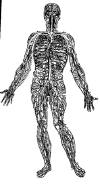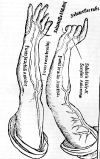A HISTORY
OF THE ARTERIES AND VEINS
 "Throughout the body the animal arteries are mingled with veins
and veins with arteries, and both veins and arteries are mingled with nerves
and the nerves with these...And of course the usefulness of such a complete
interweaving is very evident, if, that is to say, it is a useful thing for
all parts of the animal to be nourished." -- Galen, 2nd century A.D.
"Throughout the body the animal arteries are mingled with veins
and veins with arteries, and both veins and arteries are mingled with nerves
and the nerves with these...And of course the usefulness of such a complete
interweaving is very evident, if, that is to say, it is a useful thing for
all parts of the animal to be nourished." -- Galen, 2nd century A.D.
The veins and arteries of the human body have been objects of study as
long as there has been interest in anatomy. Their significance, while not
always well understood, has been an important question in the history of anatomy
and physiology. Galen, for instance, described the aorta as "a trunk divided into many branches and
twigs" that nourished the body. Ancient medical practitioners were not initially even sure
that arteries and veins did different things for the body, though they quickly
understood that they acted differently when cut -- veins being full of blood and
arteries seemingly empty. Once this was established, understanding their
relationship to each other became an especially thorny problem.
In the Galenic tradition, the venous and arterial systems were entirely
distinct. Except for the small amount of blood that allegedly crossed through
the pores in the central septum from one side of the heart to the other
to mix with the spirits, the content of the two types of vessels was believed
to be different , or at least different in degree though same in kind. The veins contained blood -- purely corporeal fluids of
the body -- while the arteries a mixture of pneuma and blood, an indication of their connection to the spiritual as well as the
material. They were associated with different principal organs as well,
namely, the liver with the veins and the heart with the arteries. Their
purposes were also distinct: veins conveyed the fluids that maintained and
nourished the body, while arteries disseminated vitality in the form of spiritus
throughout the body.
In the Middle Ages and early Renaissance, Galenic physiology continued to present the arterial and
v enous
enous
 systems as two distinct
circulatory systems in the human body. "All the arteries
[emanate] from the heart, all the veins from the liver," declared
the medieval anatomist Master Nicolaus of Salerno in the late twelfth century.
His contemporary, the Jewish philosopher Moses Maimonides, who wrote his Aphorisms
in Arabic while living in Cordoba, stated: "The difference [between
arteries and veins] is that very little and thin blow flows within arteries,
nearly gaseous, whereas very little but thick air flows within
veins." While
veins contained natural spirits, arteries contained animal spirits.
Consider the two medieval images of the body here. How
do they reflect ancient and medieval views of human physiology?
systems as two distinct
circulatory systems in the human body. "All the arteries
[emanate] from the heart, all the veins from the liver," declared
the medieval anatomist Master Nicolaus of Salerno in the late twelfth century.
His contemporary, the Jewish philosopher Moses Maimonides, who wrote his Aphorisms
in Arabic while living in Cordoba, stated: "The difference [between
arteries and veins] is that very little and thin blow flows within arteries,
nearly gaseous, whereas very little but thick air flows within
veins." While
veins contained natural spirits, arteries contained animal spirits.
Consider the two medieval images of the body here. How
do they reflect ancient and medieval views of human physiology?
Increased dissection did not
initially change these views. Yet closer examination raised fundamental
questions about the relationship between arteries and veins. "There are
many arteries and veins
 imperceptible
to the senses," wrote the Italian physician Jacopo Berengario da Carpi at
the end of the fifteenth century. He posited a complementary function of
the two systems: "There is no artery without its vein to accompany it.
Thus the artery
may keep the vein alive, and the vein may give blood to the artery in its
needs, the blood by which the vital spirit is made and the artery itself
is nourished." Berengario's contemporary, the artist and anatomist
Leonardo da Vinci, in the 1490s wrote poetically of the circulatory system as "a
tree of veins." Renaissance anatomy books certainly brought
this metaphor to life through their illustrations.
imperceptible
to the senses," wrote the Italian physician Jacopo Berengario da Carpi at
the end of the fifteenth century. He posited a complementary function of
the two systems: "There is no artery without its vein to accompany it.
Thus the artery
may keep the vein alive, and the vein may give blood to the artery in its
needs, the blood by which the vital spirit is made and the artery itself
is nourished." Berengario's contemporary, the artist and anatomist
Leonardo da Vinci, in the 1490s wrote poetically of the circulatory system as "a
tree of veins." Renaissance anatomy books certainly brought
this metaphor to life through their illustrations.
Leonardo also argued for a more unified physiology:
"All the veins and arteries arise from the heart.
The  reason for
this is that the maximum thickness found in the veins and arteries
occurs at the
reason for
this is that the maximum thickness found in the veins and arteries
occurs at the junction which they make with the heart.
The more removed
they are from the heart, the thinner they become and divide into smaller
branches." You can see an example of how Leonardo depicted the
veins here and compare it to a printed chart of the same time that helped
physicians understand how to do bloodletting.
junction which they make with the heart.
The more removed
they are from the heart, the thinner they become and divide into smaller
branches." You can see an example of how Leonardo depicted the
veins here and compare it to a printed chart of the same time that helped
physicians understand how to do bloodletting.
The idea of a single circulatory system, however, remained sufficiently unique
that the great Flemish anatomist Andreas Vesalius continued to discuss the two
systems separately in the 1530s and 1540s. Yet by the time he completed On the Fabric of the Human
Body (1543), he had begun to wonder how exactly venous blood found its way
into the arteries, questioning the idea of the porous septum in the heart.
Many anatomists already knew that the walls of the arteries were thicker than
those of the veins, but attributed this to the nature of the substance the
passed in each of them.
Further anatomical work led to the identification of puzzling features of the
veins. (1543), he had begun to wonder how exactly venous blood found its way
into the arteries, questioning the idea of the porous septum in the heart.
Many anatomists already knew that the walls of the arteries were thicker than
those of the veins, but attributed this to the nature of the substance the
passed in each of them.
Further anatomical work led to the identification of puzzling features of the
veins.
"Wherefore there are many valves in the veins opposed to the heart:
the arteries have none except at the exit from the heart. Hence the first
veins are pulsating, the latter are non-pulsating," wrote the
English physician William Harvey in 1653. These "little
doors," as their discoverer, the Paduan anatomist Hieronymus
Fabricius ad Aquapendente called them in 1603, seemed to prevent blood from flowing in more than one direction. His
famous pupil Harvey transformed these observations into a new physiology.
He established experimentally that the arteries and veins belonged to
a single circulatory system that connected the heart and lungs. In his On
the Circulation of the Blood (1628), Harvey employed animal vivisection,
human and animal dissections, and observations of living patients to establish
this new view of the circulatory system.
Harvey's well-known image of his experiment to
prove that blood flows in only one direction is depicted here
here  on the left. Look at it
in relation to the adjoining image on the right. By the 1660s, the first blood
transfusion experiments had occurred as a result of his theories and the new
fascination with vivisection. But what had happen to the ephemeral spirits that
moved through the arterial system from the heart to the brain? Where was
the life of the body, its physical soul, now?
on the left. Look at it
in relation to the adjoining image on the right. By the 1660s, the first blood
transfusion experiments had occurred as a result of his theories and the new
fascination with vivisection. But what had happen to the ephemeral spirits that
moved through the arterial system from the heart to the brain? Where was
the life of the body, its physical soul, now?
QUESTIONS: WHY DID
PHYSICIANS PERSIST IN BELIEVING FOR SO MANY CENTURIES, WITH GALEN, THAT THE
ARTERIAL AND VENOUS SYSTEMS WERE DISTINCT AND SEPARATE? WHAT ARE THE
IMPLICATIONS FOR UNDERSTANDING THE BODY IN ALTERING THIS VIEWPOINT?
Return to the History of
the Body Home Page
Some Additional Readings
 "Throughout the body the animal arteries are mingled with veins
and veins with arteries, and both veins and arteries are mingled with nerves
and the nerves with these...And of course the usefulness of such a complete
interweaving is very evident, if, that is to say, it is a useful thing for
all parts of the animal to be nourished." -- Galen, 2nd century A.D.
"Throughout the body the animal arteries are mingled with veins
and veins with arteries, and both veins and arteries are mingled with nerves
and the nerves with these...And of course the usefulness of such a complete
interweaving is very evident, if, that is to say, it is a useful thing for
all parts of the animal to be nourished." -- Galen, 2nd century A.D.






